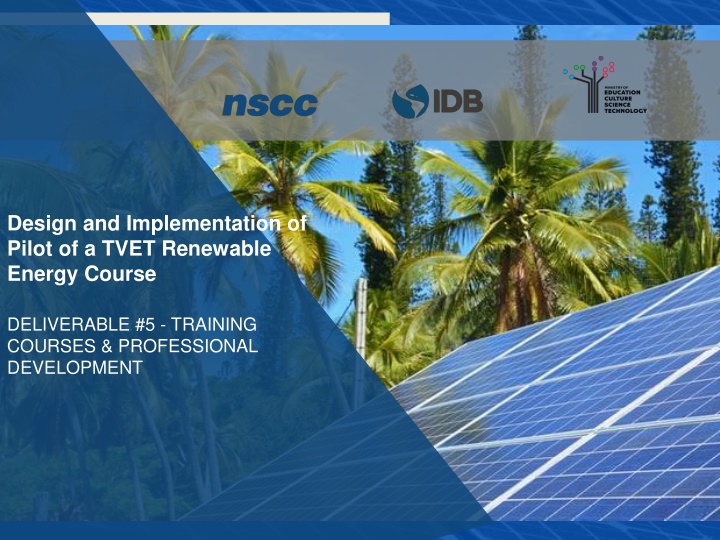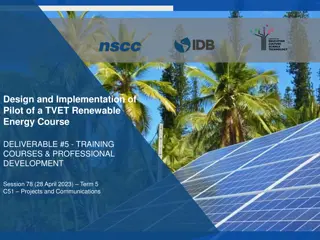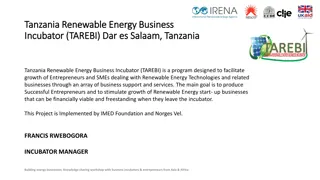Design and Implementation of Pilot of a TVET Renewable Energy Course
This module delves into the essential concepts of racking and mounting PV panels in renewable energy systems. It covers different types of mounting approaches such as roof, ground, pole, weighted (ballast), and tracking installations, providing insights into the diverse applications and benefits of each method. The reasons for pole mounting and the various mounting options are also explored, offering valuable knowledge for professionals in the renewable energy sector.
Download Presentation

Please find below an Image/Link to download the presentation.
The content on the website is provided AS IS for your information and personal use only. It may not be sold, licensed, or shared on other websites without obtaining consent from the author.If you encounter any issues during the download, it is possible that the publisher has removed the file from their server.
You are allowed to download the files provided on this website for personal or commercial use, subject to the condition that they are used lawfully. All files are the property of their respective owners.
The content on the website is provided AS IS for your information and personal use only. It may not be sold, licensed, or shared on other websites without obtaining consent from the author.
E N D
Presentation Transcript
Design and Implementation of Pilot of a TVET Renewable Energy Course DELIVERABLE #5 - TRAINING COURSES & PROFESSIONAL DEVELOPMENT
Racking and Mounting This module introduces the concepts of racking and mounting of PV panels.
Racking and Mounting Racking is the bonding of parts. It is the mechanism used to hold the PV panels and all associated equipment. There will be 5 types covered in this module.
Racking and Mounting These 5 types are broken down by the equipment used to either mount or rack the PV panels together. 1. On roof mounting / racking 2. On the ground mounting / racking 3. On a pole mounting 4. Weighted (Ballast) mounting / racking 5. Tracking mounting / racking
Racking and Mounting The third type of racking and mounting to be explored is on a pole mounting .
Racking and Mounting The most common set up is a single panel installation. There are options for multiple panel pole mounts.
Racking and Mounting Examples of pole mount PV systems: Lighting Security Traffic signal / signage Communications / SCADA (supervisory control and data acquisition) Weather station Water pumping
Racking and Mounting Questions?
Racking and Mounting The reasons for pole mounting: Small foot print A pole already exists Out of reach Need height Adjustable tilt option
Racking and Mounting There are two mounting options. Top of pole mount. Side of pole mount. Pictures courtesy altestore.com
Racking and Mounting Questions?
Racking and Mounting The mount will have the ability to fasten to a round object. https://hespv.ca/media/wysiwyg/infortis/ultimo/m ounts/TPM-FOUNDATION-GUIDELINES.pdf This link has information that underlines the need to know soil conditions. The base needs to be able to support the wind conditions.
Racking and Mounting As in ground mounted systems a wind loading profile needs to be conducted. This example will follow the AltEstore design tool. https://www.altestore.com/store/solar-panel- mounts/top-of-pole-mounts-for-solar-panels- c514/
Racking and Mounting The first step is to know the PV panel size. This will help determine the area exposed to the wind.
Racking and Mounting Find the following site conditions: Wind / snow load (Belize = no snow load) Soil conditions Options for the mount
Racking and Mounting Max wind speed - standard mounts can withstand 90-100 mph winds. High wind version mounts available for higher zones. Desired tilt angle - with most mounts able to be seasonally adjusted, what is the best angle it should be set at for most of year
Racking and Mounting Soil type - is the soil crystalline bedrock, sedimentary rock, sandy gravel, silty sand, sandy clay. Exposure category - is the site sheltered with buildings or forests, or open/flat, or on the coastline/severe conditions (B-C-D). Foundation shape and size - what is the diameter of the hole that will hold the mount, that concrete will be poured into.
Racking and Mounting Pole mount installs easily over standard Schedule 40 or 80 rigid steel pipe. This is not included with the mounts normally.
Racking and Mounting Dig hole according to recommended depth and diameter. Once pole is in ground, use level to make sure it's vertical to the ground. Brace pipe to prevent it from moving during the concrete pouring. Allow concrete to cure. Backfill around pole.
Racking and Mounting From the altestore, this link opens a calculator to entre the data required. https://www.mtsolar.us/top-of-pole-mount- calculator/
Racking and Mounting This is the pop-up screen (ensure pop-ups are not blocked in your browser). Scroll down the page.
Racking and Mounting Start to add information. Check the Dimensions for accuracy. There was no option for 1 panel.
Racking and Mounting 15 degrees is optimal for Belize. 8 feet was selected to keep out of reach. Any height is acceptable.
Racking and Mounting Worst case scenario is 185 mph wind speed. Exposure D ( Covered in previous modules) Belize snow?
Racking and Mounting The choice for shape is either round or square. There are a number of widths to pick from. 5 types of soil conditions are available to be selected.
Racking and Mounting The calculator provided the following information.
Racking and Mounting The calculator is a good tool for students to input various conditions. Students can explain the designed differences.
Racking and Mounting Questions?
Racking and Mounting Side of pole mounts are easy to install. Typically used for small numbers of solar modules (usually no more than 4 modules).
Racking and Mounting Sunwize has many side of pole mounts. This link is to just one of their many mounts. https://www.altestore.com/static/datafiles/Others /SW-SOP-mounts-10-12.pdf
Racking and Mounting Note the wind speed rating. Pictures courtesy Sunwize and altestore.com
Racking and Mounting Questions?
Racking and Mounting Pole mounted solar panels are usually part of a stand alone system. They have all of the components to provide energy. Basic system components are: PV panel Battery Charge controller
Racking and Mounting The complete pole mounting system normally has an enclosure to house the accessary equipment. The enclosure can be mounted to the pole or a nearby structure. The enclosure needs to be weather proof.
Racking and Mounting NEMA (the National Electrical Manufacturers Association) has a rating system for outdoor equipment like enclosures. Type 3R Type 4 Type 4x Each of these are acceptable but there are differences.
Racking and Mounting Type 3R: Intended for outdoor use. Provides a degree of protection against falling rain and ice formation. Constructed with knockouts on the sides and bottom.
Racking and Mounting These are not rain-tight, which means exposure to beating rain could result in water entering. Nor are they water-tight, which means moisture could enter when subjected to a stream of water under certain conditions. This style of enclosure does not have a gasketed sealing surface.
Racking and Mounting Type 4: Weather tight (weatherproof) enclosures. Constructed for either indoor or outdoor use. Provide a degree of protection against falling dirt, rain, sleet, snow, windblown dust, splashing water, and hose-directed water.
Racking and Mounting Type 4X: Same as Type 4 except constructed from corrosion-resistant material. Corrosion-resistant as defined by industry standards. Constructed to provide a degree of protection against exposure to corrosive agents such as salt spray.
Racking and Mounting The complete pole mount and the associated equipment including the enclosure. Picture courtesy author
Racking and Mounting Close up look at the locked enclosure. Picture courtesy author
Racking and Mounting Questions?























